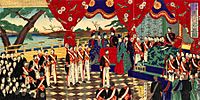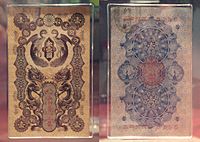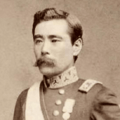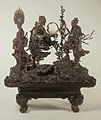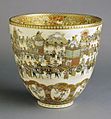Meiji period facts for kids
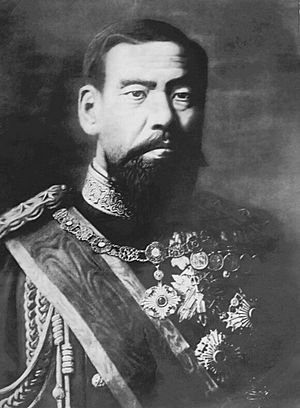
Meiji period (明治時代, Meiji-jidai), also known as the Meiji era, was a Japanese era name (年号,, nengō,, lit. "year name") after Keiō and before Taishō. This period started in September 1868 and ended in July 1912. During this time, the emperor was Meiji-tennō (明治天皇).
The nengō Meiji means "Enlightened Rule" or "Enlightened Government".
Events of the Meiji period
The years in which Meiji was the Japanese monarch comprise this modern period or era.
- 1868 (Meiji 1): Meiji Restoration; the capital of Japan moved from Kyoto to Tokyo.
- 1889-1890 (Meiji 22-23): Constitution of the Empire of Japan
- 1894-1895 (Meiji 27-28): First Sino-Japanese War
- 1904-1905 (Meiji 37-38): Russo-Japanese War
- 30 July 1912 (Meiji 45, 30th day of the 7th month): Meiji died.
Politics
- 1885 (Meiji 18): Ito Hirobumi became 1st Prime Minister
- 1888 (Meiji 21): Kuroda Kiyotaka became 2nd Prime Minister
- 1889 (Meiji 22): Yamagata Aritomo became 3rd Prime Minister
- 1891 (Meiji 24): Matsukata Masayoshi became 4th Prime Minister
- 1892 (Meiji 25): Ito became 5th Prime Minister
- 1896 (Meiji 29): Matsukata became 6th Prime Minister
- 1898 (Meiji 31): Ito became 7th Prime Minister
- 1898 (Meiji 31): Ōkuma Shigenobu became 8th Prime Minister
- 1898 (Meiji 31): Yamagata became 9th Prime Minister
- 1900 (Meiji 33): Ito became 10th Prime Minister
- 1901 (Meiji 34): Katsura Tarō became 11th Prime Minister
- 1906 (Meiji 39): Saionji Kinmochi became 12th Prime Minister
- 1908 (Meiji 41): Katsura became 13th Prime Minister
- 1911 (Meiji 44): Saionji became 14th Prime Minister
Gallery
-
The 15-year-old Emperor Meiji, moving from Kyoto to Tokyo, end of 1868, after the fall of Edo]]
-
Formal beginning of the Meiji Constitution, 1889. Woodblock print by Toyohara Chikanobu
-
First Meiji one-yen banknote, 1871
Related pages
Images for kids
-
Emperor Meiji in his fifties.
-
Ginza in 1880s.
-
Hokkaidō Development Commission Sapporo Main Office (Historical Village of Hokkaido)
-
Tsuruma Park, 1910; in January 1873 the Dajō-kan issued a notice providing for the establishment of public parks, that of Ueno Park following shortly after
-
Japanese soldiers in front of Kankaimon gate at Shuri Castle at the time of the so-called Ryūkyū Disposition
-
"Waves" maki-e panel by Shibata Zeshin, 1888-1890
See also
 In Spanish: Era Meiji para niños
In Spanish: Era Meiji para niños



